The Building at Dornach
GA 288
23 January 1923, Dornach
Lecture I
[ 1 ] As a sort of episode inserted between the lectures now being given, I should like to-day to bring forwards a few things about our building, so that our friends may find in what will be said, a sort of foundation for their own work. We shall have, in the near future, to take strong measures in different directions for the benefit of the cause, so that the Dornach Building, the “Goetheanum”, should be made the centre of the movement for Spiritual Science from the point of view of Anthroposophy for which we intend to work. It would be of great importance if the Goetheanum could also be made known to the outer world, so that those who have not at present an opportunity of seeing it, may become acquainted with it. The very way in which this building is put before the spiritual culture of the present time may, if brought to the consciousness of our contemporaries in the right manner, work in the direction, which we consider is the needful direction for the age. So to-day, when I have said, I wish to provide a foundation for that which others will carry forth into the world, I will once more give you a little of what I have already expounded here in other connections, so that from what is contained in these episodic lectures, a complete conception of the whole may be formed.
[ 2 ] To begin with, it must be stated that the Dornach Building has grown out of the Anthroposophical conception of the world. The Building was able to grow forth from this for the very reason that when this conception is rightly understood, it will itself possess the inner force with which to create its own artistic forms and figures. Once again, I should like to repeat what I have said before in other connections, that if any of the spiritual tendencies of the present, which with their various programmes come before the world to-day, had at any time required a building of their own, some architect or other, and some artist or other would have been approached, who would have built a house in such and such a style, in which the movement it was built for could have been carried on. There would have been an external relation between what went on within it and the building itself, which might be either of the Renaissance period, or of ancient Gothic style.
[ 3 ] There must not be any such merely external relation between the conception of the world which is to be given forth at Dornach and that which encloses its activities. The relation between them is to be an inner one. Every detail connected with the housing of our activities, every detail of form and figure had to proceed from the impulses of this world-conception itself. If you bear this in mind, you will see, that this is connected with the position Spiritual Science or Anthroposophy claims in the whole development of mankind. The life of modern humanity has become simply intellectual; it has become so because for centuries modern humanity has hardly received any other education than that of thought. When forms have to be created, people turn to those already existing to some one or other of the old styles of architecture; just as when they wish to make anything artistic or such-like, they do not turn their minds to the conception of the world, but to something which has been substituted in its place. What actually brought this state of things about? [ 4 ] You see, in everything of note in human culture there have always been two streams flowing together. The presence of those two streams can be traced far back in the historical development of mankind. One of these, which has achieved its greatest intellectual development in the last few centuries, can be traced back to what we may call the Old Testament outlook on the world. We must never lose sight of the fact that one of the essential tenets connected with this was the command: “Thou shalt not make to thyself any graven image of the Lord, thy God”. The pictorial representation of that which is of a spiritual nature, was lacking in the one stream of human development. And this still holds good up to the present day in the modern development of this stream.
[ 5 ] Many schools of thought and of philosophy, many different sciences and popular conceptions of the world have been built up, but none of these have, of themselves, succeeded in creating artistic forms. All that has been achieved is the establishment relationship with the inartistic element of the present day conception of the world. Our modern age is not concerned with creating new forms, or with giving shape to what is capable of representation.
[ 6 ] But really there are two entrances into the world of the spirit; it may be entered in the intellectual way in which it is penetrated by the monotheistic religions, in which case the thought element, the intellectual, is principally developed. By this means great progress can be made along the lines followed in our most recent times. Or, on the other hand, the element which is to be found in the imaginative may be cultivated, the element of vision, of life in course of formation. modern humanity has not much living relation with this latter element. It revives bygone styles, old methods of artistic representation, but never identifies itself with them. Indeed, things have gone so far that, on the one hand those who wished to create artistically had an actual fear of every kind of philosophy, for it is quite reasonable to stand in some sort of fear of the modern world-conception, which is imaginative an intellectual. Put on the other side this has been a great disadvantage in another sense to the development of modern humanity. This disadvantage itself is the sign of decadence of recent times.
Some time ago in this very place, I drew attention to the fact that in all the present struggles of humanity there is something of the Jehovah-striving of the Old Testament, that in a sense an endeavor was being made to make each individual people what the Old Helm wanted to make of themselves and that Christianity, as such, has not fully entered the hearts of modern humanity. And so a certain intellectual thinking, an intellectual feeling concerning humanity as a whole, has in a one-sided way grown up round our social life. But man as man, 0r man as a community, can never be understood from a purely intellectual standpoint.
[ 7 ] What man is, that in him which enables him to take his place in social life, can only be understood if we rise to imaginative conception. Anyone who is acquainted with the law to which such things are subject, is aware that even the Fairy Tales, the legends and various mythologies contain more wisdom concerning the real nature of man than does modern science, which does not even possess the means of giving man an explanation as to himself. People are afraid of the inpouring of the spiritual, which can only manifest in our human civilisation in the form of pictures; they dread it. But our civilised life will never be raised until men's hearts are once again filled with a conception of the world not only capable of forming from itself thoughts, but of creating forms and permeating the whole of life. We want to make a beginning, yet in its own way it is intended to show all that can be accomplished by a really creative conception of the world at the present time and more especially what it must do in the future. In a sense you see before you, in a picture, all that is characteristic of the conception of the world which is studied here, when you are confronted with that which is meant to be representative of it, when you see the Goetheanum on its hill, at Dornach.
[ 8 ] If we wish to describe in a few words the special characteristic of this conception of the world, it is this: The realisation that in this age a new spiritual life must be revealed to man. And as we approach the building which is to stand for the spreading of this new spiritual life, we cannot but feel that a new revelation is to he made. Anyone who draws near to it cannot help feeling that something will reveal itself here, something new in the development of humanity. The very shape of the building impresses you with the sense of something new making its way into the development of man. Two cylinders of circular shape, in neither of which is the circle complete, covered with hemispheres equally incomplete, expresses the duality of that which is revealed and of that which comes to meet it. The very predominance of the two domes conveys an impression to the observer, as he draws near, that something is enclosed herein, something enclosed but which intends to make itself known.
[ 9 ] Do not take what I an now saying in a symbolical sense; take it in an artistic sense and you will then develop the right understanding for it. I shall have to speak further about these things, but this evening we will begin by making a survey of the different effects produced by the contours of the building, seen from without. Let us begin by supposing that someone approaches if from the North-East from any point around the hill on which the Goetheanum is erected. He would then see a Building (Picture 1) which could be in no other form. This is the feeling which ought to be experienced, when directly confronting that which stands as the representative of a new world-conception.
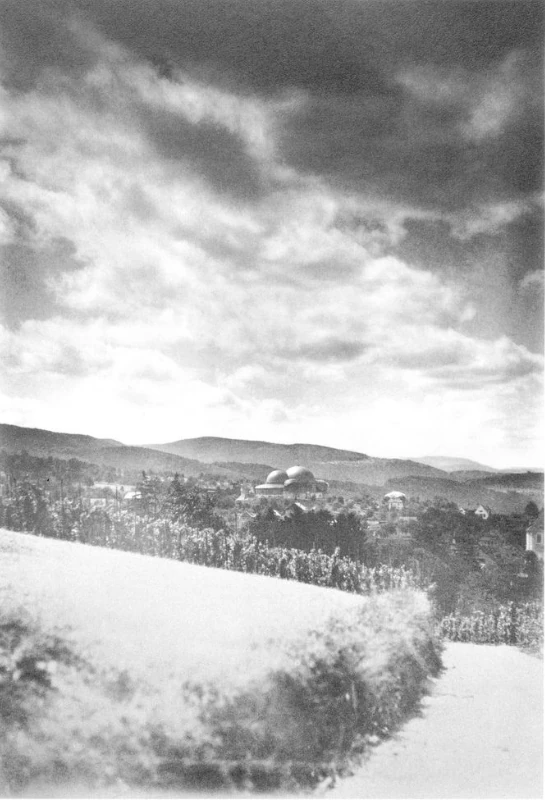
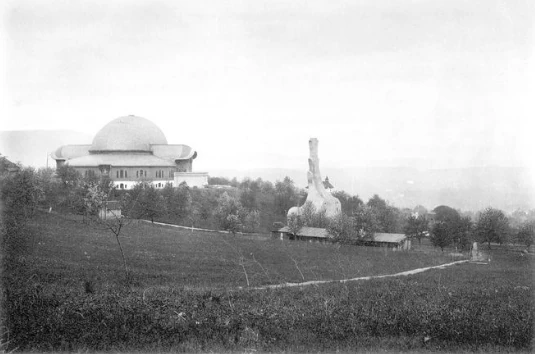
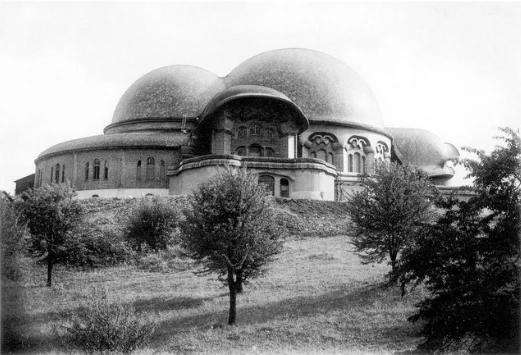
[ 10 ] It is first of all necessary to study the different forms. It was in 1908 that the thought first occurred to me to erect a building with twin domes. But much of the original plan had to be altered, for it had originally been intended to put it in a city, in Munich, where it would have been surrounded by houses, where the outer architecture would not have had to be so much considered. When the building had to be remodelled to stand upon its present hill, it became of course necessary to so plant the outer architecture that it might produce the right effect from the different points of view in the neighbourhood. Here let us begin by noticing that the building stands on a sort of platform, not absolutely on the ground.
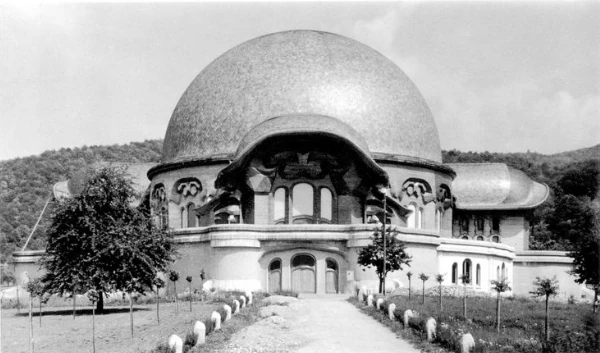
[ 11 ] We now draw rather nearer to the Building and this is a picture of the principal entrance. Kindly observe you begin by entering the substructure and that, as we shall see, the staircase by which we ascend to the auditorium belongs to the substructure of the Building. Having ascended that, we then enter by the main door into the real Inner Hall. The Building stands rather above the level of the actual surface of the ground. It will be apparent to anyone who approaches the Building, especially when he finds himself opposite the main door, that an attempt has here been made to depart from the usual purely mathematical-geometrical-mechanical structure forms, and to discover organic ones. Of course those people who are quite accustomed to the old conception and who believe that the geometrical-dynamic can alone rightly hold a place in the art of building and in architecture will have many objections to bring against this introducing the forms of architecture into organic forms. All these objections are known. But here we have actually dared to make the attempt. [ 12 ] Then, however, we had to think the whole thought of the Building as of a living organism. No one will understand what I mean by this, unless he himself really makes the endeavour—which very few people will do as yet—to turn his feelings away from all that is symbolical and intellectual, from everything merely mechanical and mathematical, and allows himself to be carried into a really organic-artistic, a feeling way of thinking. This does not imply that the form of an organic being is symbolically expressed in the structural forms, it means that in order to understand an organic being we must realise that a quite special sort of intuitive thought-form is necessary. We shall have to become accustomed to these intuitive forms of thought. And we then ought to be able to find these architectural forms even coming of themselves quite originally and elementally, out of the intuitive thinking.
[ 13 ] I should like to draw your attention to something of which most people in the present day have no suspicion. It may be said that in nature there are organic forms. Structural forms are made, more or less modelled on some such organic forms in nature, structural forms which in a sense are a symbolical expression of the organic forms of nature. But nothing of that kind has been done. There is no direct prototype in nature of structural forms here. And if a man seeks for such in nature, it only shows that he has failed to understand the whole basic thought of what is in question here.
[ 14 ] To be capable of understanding an organism is a very different thing. For when a man really understands a natural organism, he then possesses a kind of thinking which is able to find organic structural forms quite independently of nature. But such forms as these must be discerned in complete independence, they must be created from out of their own form-essence. They will then, if they result from a real living structural thought, bear the nature of the organic. What then is the nature of the organic? Well, take as an example the most complicated organism, man, and then take merely the lobe of his ear; if you have the right intuitive thinking and feeling, you will say that the lobe of the ear, situated where it, is, could be no other than it is; in its place it must be just as it is. It is the right width, the right height, and is properly rounded off, and so on. And this must be so in every single form in this organically conceived Building. Each detail, in that it represents a part of the whole, must make evident in its own form that it is indispensable. The very smallest appendage in the different parts of the Building must be as manifestly indispensable as the lobe of the ear, or an arm or a hand is to the human organism.
[ 15 ] Nothing here has been copied from nature. And if these forms remind anyone of this, that or the other, it only shows that he is not judging of the Building from the standpoint of Art, but that his opinions are inartistic. If the forms in the Building remind one of anything—and what is there that people have not been reminded of—human eyebrows and eyes and so on—that only proves that he is judging of each thing on its own merit, especially; whereas each detail in the Building only has a significance in its connection with the whole and must be so understood.
The next picture shows the same, a little nearer.
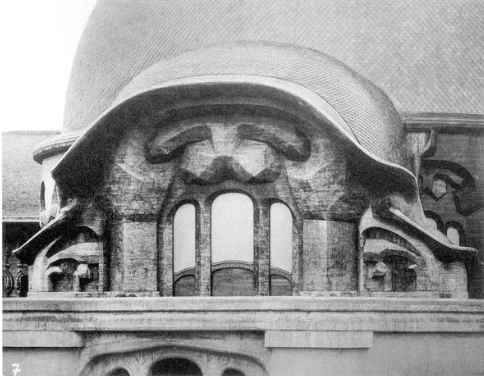
[ 16 ] Below we see the entrance; facing us are the cloakrooms; and to the right and left, where the substructure extends in a circular direction, is the well of the staircase. We then go up the stairs and through the main door, by which we enter the inner building. The motive which we encounter in the main entrance is one if those organic motives to which we have been referring. If you take the various motives that are to be found on the different sides of the Building you will find that they are always formed in accordance with the organic principles of metamorphosis, so that the one always grows forth as a development of the other. For instance, look at the motive here, above the principal entrance. If you can feel it in its forms, you will feel the same form again in the motives of the window of the side-terrace, which you can distinctly see here to the South. (Figure 14) The motives of the windows are apparently quite different. But in studying them you will see that they develop out of that one over the principal Entrance in the same way as, according to Goethe's principle of Metamorphosis, the different organs of the blossom develop from the leaf. It is again a metamorphosis of the same motive. We can only develop a living thought of the Building, if we really inwardly and intuitively grasp the principle of metamorphosis.
[ 17 ] In what is attached right and left of the Principal Entrance you can see that the attempt has been made, just as it is in nature itself, to cause one motive to proceed out of another; although there has been no copying of what is organic. In every line and surface you can see that they all proceed from the same principle—like that same principle which causes the cheek to be carried from the temple of the forehead in a human face. The evolving of the cheek from the temple of the forehead might really be taken as a subject of inner study. Only while doing so we must be free from the purely intellectual ideas of the world. We must be able to view the world in forms, without beginning to symbolise. We then shall be able to see how one surface, one form, proceeds out of the other in such a way that they might really have grown forth; and besides that, they really belong to the place where they are. [ 18 ] Now in the whole of this building there is not a single thing that is mere symbol. At the time when our movement still had many people in it who were full of sectarianism and false mysticism—which tendencies indeed I had to fight over and over again—but when there were these tendencies in the different persons who came into our movement from co many different quarters, persons of artistic natures who happened to come among us were often horrified at this tendency to symbolise. These members valued a Rose-Cross, a cross with seven roses, far higher than a really artistic motive. Now in this building we may say that this has been definitely overcome and that what is really creative in a conception of the world has been expressed in forms without any transition though the symbolical.
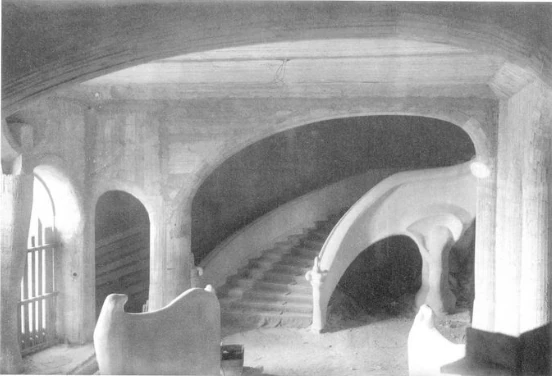
[ 19 ] I want you to notice that in the forms, (though of course all this is only a beginning) an attempt has been made so to shape the surfaces that they lean towards the corresponding centres of support. (Kräfte-Lagen). For instance, if you go in at the principal entrance of the substructure, you will see the arches. If you study the forms of these arches you will find them so constructed that their lines follow the distribution of weight of the building. Towards the door, where the weight is less, the arch is wider; where the arch curves towards the building it bends inwards, the curve is arrested. Thus the forms of the arches correspond to the distribution of weight. If you can feel the forms in this way, you have grasped a structural thought.
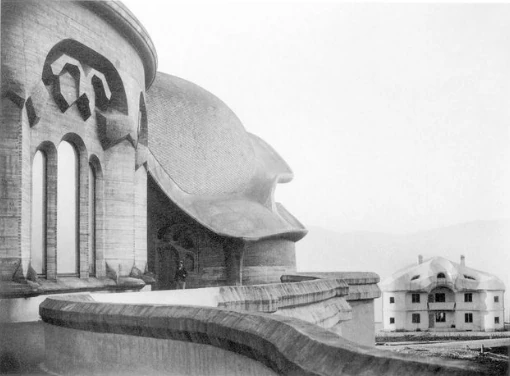
[ 20 ] We now obtain a view of the North side. In the part between the principal entrance and the one wing, you can see the motive of the principal entrance in metamorphosis. There you can study the metamorphosis of the separate forms, which allows for the motive of the side-wall which is to follow. When you go in at the principal entrance the motive meets you, whereas here you pass it by. An organic structural thought should express whether a motive is one that is to meet the eye, or is to he passed by. It is the same motive, in different states of metamorphosis. Similarly that which finishes it above, which overhangs the motive—is only a metamorphosis of that which is the motive of the main portal. it is differently formed, but has only become different in the course of its metamorphosis; it is the motive of the principal entrance.
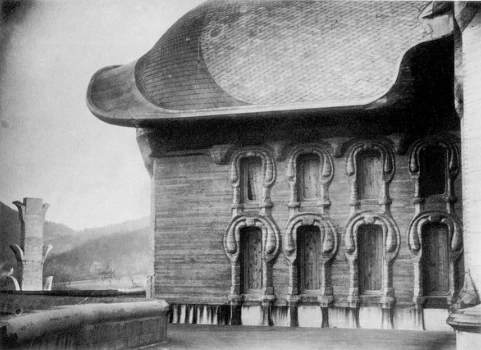
[ 21 ] Here you have the side-view of the side-terrace. In the motive of these windows, you can study how organic shapes are formed. The motive completing the windows above is precisely the same as that you have just seen over the windows and the motive over the principal entrance, only in an organic growth it is the case that metamorphosis comes about through that which in the one structure is wider and more forceful, becoming contracted and condensed in the other; what in its earlier state as in a more primitive form, extends to more ramifications. It is just in this that metamorphosis consists, and here you can see it carried out. [ 22 ] And I should like to draw attention here to the fact that in the whole building the endeavour has been made to develop structural truth, architectural truth. That is actually very little understood in the world to-day. You can here see the overcoming of the mere Renaissance idea. The setting of windows is not merely decorative, but as you see it arises from below. In the whole building there is not anything to be
found which does not convey its actual purpose.
Nothing in this building lies, whereas in the present-day conception of architecture there is an enormous amount of untruth and deception. In our civilisation there is so much untruth in our forms that it can hardly be wondered at that so much of what men say is untrue too. Here the endeavour has been made that everything shall absolutely and truthfully express what it actually is. This can never be the case in symbolism, which always contains something arbitrary. I want you to take note of this.
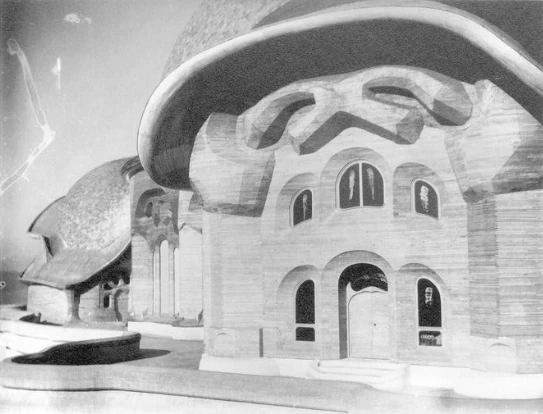
[ 23 ] Here we have the facade of the side terrace. You see in metamorphoses that which is above the principal entrance. Of course, you must bear in mind that whatever you see here is nothing but a new beginning. I always say over and over again, to all who will listen, that if I had to construct the building over again, it would be very different. This is just an attempt. But in its different parts you can see what we really intended, how the organic structural thought has been carried out, and how, for instance, the merely mathematical-geometrical-dynamic column formation has been developed into the organic, so that nowhere is the principle, merely of support or of burden in evidence, but everywhere the principle of growth can be seen, the coming forth of one from another. And as we shall see tomorrow, there is a marked effort to carry out this idea in the architecture of the interior.
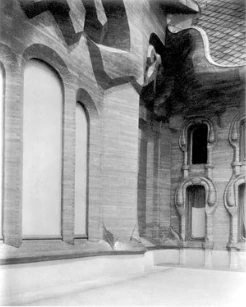
This is the juncture seen from the side, seen from the corner.
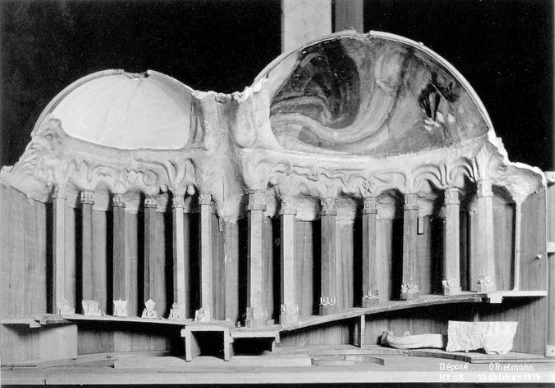
[ 24 ] The model of the building. Here you have the picture of my original model. I wanted first of all to give you a conception of the idea one receives in approaching the building. I wanted to show you the effect it ought to produce when you walk round it. now show you the inner part, in my original model, carried out in wood and wax. This model was the basis of the whole building. You see it here cut in two through the centre. You can thus see under the great cupola.the seven columns which, in succession, encircle and enclose the auditorium. Here in the middle is the place of the Drop-Scene, and here beneath the smaller cupola you see 6 of the 12 columns which encircle that space. As here seen, the building is divided from West to East. In the East will stand the principal Group: the Representative of Humanity, in the midst of the Luciferic and Ahrimanic elements. Concerning the principle by which these columns with their capitals and architraves were constructed, I shall steak tomorrow.
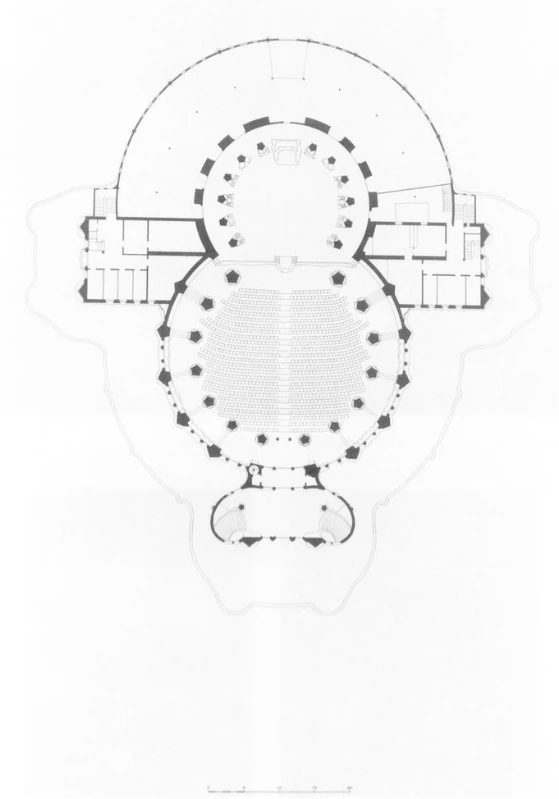
[ 25 ] Here we have the ground-plan of the building, the principal entrance with the staircase on either side, the auditorium, and the space beneath the small cupola, the place in which the Mystery-plays and the Eurythmic-representations and so on, will be given. These two spaces will be divided by the curtain. On the line dividing the two will be the speaking-desk, on both sides of this dividing line are the two side-alleys, for the use of those engaged in the representations, and their dressing-rooms and so on.
[ 26 ] This ground-plan will show you that certain things were indispensable to the building. Whenever I refer to this ground-plan I am always anxious lest the actual structural thought should be misunderstood. I once gave a lecture in Dornach on this ground-plan and its form, drawing a comparison between it and the human form. Some of my listeners jumped to the conclusion that the building was a symbolical image of the human form. That is absolutely not the case; but if a man is able really to understand the human form and how on the one hand it is an instrument for thinking and on the other hand for willing and that both these are held together by the power of feeling; if he understands the whole human structure, the formation of the head, and limbs and the trunk, with the heart system as the centre, he then would also be able to construct other organic forms. And this is one of these other organic forms. On this account when one sees this and the organic form of man together, it is possible to find a certain relation between them. But there is absolutely no question of the one being modelled on the other, for the Building here is in its organic architectural form constructed from out of that which is organically creative in nature and from cosmic activity itself.
You will be able to see the same in the transverse section that I will now show you.
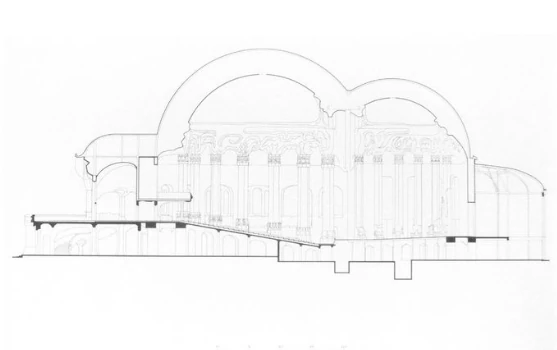
[ 27 ] The small cupola, as connected with the great cupola. This cut through the centre from East to West. The whole Building has but one axis of symmetry and everything is arranged in accordance with that. That necessitates the structural thought being a living one, for the more highly evolved organism develops along a certain axis. Certain lower organic forms alone evolve from the centre; and we may take it, that as a result of the attempt that has been made here, certain more perfect forms of building than the centrally constructed (Zentralbauten) ones, will be developed, because a first beginning has been made to follow the principle of organic growth along an axis.

[ 28 ] Here you have the vestibule into which one enters through the door of the substructure; and this is the stairway by which one ascends to the terrace. You see that, forming part of and attached to the balustrade of the stairs is a remarkable structure. What this actually is can perhaps only be completely grasped by one who is able to look away from everything merely intellectual, in order to see only the artistic. When this form was about to be made, I said to myself: anyone going up these stairs must have some sort of halting-place, to bring about in him the right frame of mind. Now just look at these three directions of space. But it will not suffice to look at them, you must notice how they droop over and bulge out, how weighty they are, bending over with their own weight. If you take the whole form into your feeling, they will be to you,the expression of the mood which it would be desirable for you to have when you ascend these stairs. Anyone who goes up them will have a premonition that here, in this Goetheanum Building, he will find something which will give firmness, security and strength to his life, which will give him something to his balance. One ought to have that feeling here, for simply from that feeling did the form arise. I might say that besides this, one should feel that the form must be what it is, for although it is not slavishly copied from them, it does resemble the three semi-circular canals which form the small auditory bone of the human ear. If this organ of the human ear is injured a man falls, he loses his balance. It is an organ of balance in the human organism, a diminutive organ of balance.
[ 29 ] Now one cannot help feeling that there must be something here to help us to enter the Hall in a properly balanced frame of mind. This is no puzzled-out idea, it has been really felt. If one takes it as a thought-out thing, it will be his own fault, for it shows he has begun by reflecting and digging down and speculating. There should be no question of speculating or puzzling out, but of feeling the heavy pressure of the overhanging weight of feeling the form and in so doing, of arousing the mood that may come over one while mounting these stairs.
[ 30 ] Here is one of those vaulted arches which can only be understood by organic structural thinking. If you stand here in the Building and feel the Building, that is, feel how you come in or out there, and how you go up the stairs, meeting all the weighty pressure of the whole Building, you will then feel this curve is expressed exactly as it should be: while at the same time you will feel what the whole structure means. The attempt has here been made to give over to the organic the work that is generally done by columns or pillars. There is nothing in this but the feeling for form that comes when one intuitively feels the supporting strength, which this particular form must convey. If anyone is reminded of an elephant or a horse's hoof he may be so but, that only shows that he does not consider it from an artistic point of view, but merely an imitative one. What is important here is the being able to feel that weight has to be supported, while that which is to bear it grows into this form, develops into it, and that this arch could curve in any other direction but this. It is not a question of copying anything, but of trying to feel the weight-carrying, weight-bearing forces, and of moulding such forces as are able to bear weight.
[ 31 ] In the ordinary-structural-conception the geometrical-mechanical-dynamic weight-bearing and carrying, is the only feeling one has. But here in every surface and line should he expressed in the structures, the beginning of the feeling for life. If the things I have mentioned do away with all that is merely speculation, you will have understood the subject in the right way.
[ 32 ] To-morrow we will continue and pass from the outer to the inner architecture. I believe that when all that underlies the conception of our Building is made known to the world, and it is shown that here something really new in the way of artistic forms is growing out of the Anthroposophical conception, we shall be able to arouse a feeling for all that is being done not only in this line, but also in regard to the social question.
Erster Vortrag
[ 1 ] In einer Art von episodenhafter Einfügung in diese Vorträge, die jetzt gehalten werden, möchte ich Ihnen heute einiges vorbringen über unseren Bau, und zwar so, dass unsere Freunde in dem, was über diesen Bau hier dargeboten wird, eine Art Unterlage haben können für ihr eigenes Wirken. Es wird sich ja in der nächsten Zeit wirklich darum handeln, dass nach vielen Richtungen hin stärker eingetreten wird für unsere Sache, und dass der Dornacher Bau, das Goetheanum, in den Mittelpunkt gestellt werde desjenigen, was wir als Bewegung für die anthroposophisch orientierte Geisteswissenschaft geltend machen wollen. Es würde von außerordentlicher Bedeutung sein, wenn dasjenige, was hier als «Goetheanum» sich befindet, der Außenwelt auch bekannt würde, bekannt würde auch denjenigen, die jetzt nicht Gelegenheit haben, diesen Bau zu besehen. Die Art, wie dieser Bau sich hinstellt vor die Geisteskultur der Gegenwart, die kann schon, wenn sie in der richtigen Weise unseren Zeitgenossen zum Bewusstsein gebracht wird, in der Richtung wirken, die in diesen Betrachtungen als eine notwendige Zeitrichtung angegeben worden ist. Ich werde daher heute - da ich ja, wie gesagt, Unterlagen geben möchte für dasjenige, was dann andere in die Welt hinaustragen können - einiges von dem, was ich im einen oder anderen Zusammenhange schon vorgebracht habe, wieder vorzubringen haben, damit dann aus dem, was diese episodischen Betrachtungen enthalten werden, eine Art von Ganzem entstehe.
[ 2 ] Dasjenige, was in erster Linie mit Bezug auf den Dornacher Bau zu sagen ist, das ist, dass er herausgewachsen ist aus der anthroposophisch orientierten Weltanschauung. Herauswachsen konnte er aus ihr aus dem Grunde, weil diese anthroposophisch orientierte Weltanschauung, wenn sie richtig verstanden wird, die innere Kraft hat, wirklich aus sich heraus Formen, Künstlerisches, Gestaltungen zu schaffen. Noch einmal möchte ich dasjenige sagen, was ich in anderem Zusammenhange schon gesagt habe: Würde irgendeine der heutigen Geistesströmungen, wie sie mit verschiedenen Programmen vor die Welt hintreten, in einem gewissen Zeitpunkt eine eigene Behausung gebraucht haben, so würde man sich an diesen oder jenen Architekten gewendet haben, an diesen oder jenen Künstler und würde eine Art so oder so stilisierten Heimes gebaut haben, in dem dann dasjenige, was sich geltend machen will, wohnen könnte. Es wäre ein äußerliches Verhältnis dann zwischen demjenigen, was da getrieben würde, und einem Renaissancebau oder einem antiken Bau oder einem gotischen Bau oder dergleichen.
[ 3 ] Ein solches äußeres Verhältnis sollte nicht sein zwischen dem, was hier als Weltanschauungsich offenbaren will, und demjenigen, was ihre Betätigungen umschließt. Es sollte ein innerliches Verhältnis sein. Alles Einzelne, was zur Behausung unserer Tätigkeit gehört, alles Einzelne in den Formen, in den Gestaltungen, sollte aus den Impulsen dieser Weltanschauung selbst heraus geschaffen werden. Wenn Sie dies bedenken, so werden Sie sehen, dass es zusammenhängt mit der ganzen Stellung, welche sich anthroposophisch orientierte Geisteswissenschaft zur allgemeinen Menschheitsentwicklung geben will. Das Leben der neueren Menschheit ist abstrakt und intellektuell geworden. st so geworden, weil durch Jahrhunderte hindurch die neuere Menschheit fast nur eine Erziehung in Gedanken durchgemacht hat. Wenn man Formen schaffen wollte, so wendete man sich an schon Bestehendes an diesem oder jenem alten Baustil, wie man sich auch sonst, wenn man Künstlerisches oder dergleichen schaffen wollte, nicht an die Weltanschauung wendete, sondern an irgendetwas, was sich neben die Weltanschauung hinstellte. Woher ist denn das eigentlich gekommen?
[ 4 ] Sehen Sie, in allem, was sich in der menschlichen Kultur geltend macht, müssen zwei Strömungen zusammenfließen. Diese zwei Strömungen gehen weit in der geschichtlichen Entwicklung der Menschheit zurück. Die eine, die ihre intellektuellste Ausgestaltung eben in den letzten Jahrhunderten erfahren hat, geht auf dasjenige zurück, was man die Anschauung des Alten Testamentes nennen kann. Man darf niemals aus dem Auge verlieren, dass ein Wesentliches in diesen Anschauungen des Alten Testamentes das war: Du sollst dir kein Bild machen von deinem Gotte. Die bildliche Darstellung desjenigen, was geistiger Art ist, das war etwas, was dieser einen Strömung der Menschheitsentwicklung fehlte. Und so ist es in dem, was geworden ist aus dieser einen Strömung der Menschheitsentwicklung, bis zum heutigen Tage geblieben.
[ 5 ] Es wird da viel gedacht, es wird philosophiert, es wird gewissenschaftet, es werden populäre Weltanschauungen ausgebaut. Aber diese Wissenschaften, diese Philosophien, diese religiösen Strömungen bringen es nicht dazu, aus sich selber heraus künstlerische Formen zu schaffen. Man hat aber eigentlich nur zu dem unkünstlerischen Elemente des Weltanschauungsstrebens in der neueren Zeit ein innerliches Verhältnis. Zum Formgeben, zum Ausgestalten des Bildhaften hat die neuere Zeit ein unmittelbares menschliches Verhältnis nicht.
[ 6 ] Nun gibt es aber eben zwei Eingänge in die geistige Welt. Man kann abstrakt in die geistige Welt eindringen, so wie die monotheistischen Religionen eben abstrakt eindringen. Dann bildet man vorzugsweise das intellektuelle Element, die Abstraktheit aus. Dann bringt man es weit in dem, worin es die neueste Zeit weit gebracht hat. Man kann aber auch ausbilden dasjenige Element, welches im Bildhaften liegt, das Element des Anschauens, des Lebens in der Gestaltung. In diesem Elemente lebte innerlich die neuere Menschheit wenig. Sie erneuerte alte Stile, alte Bildlichkeiten, gelangte aber zu keinem innerlichen Verhältnis zu diesen. Ja, es ist so weit gekommen, dass auf der einen Seite diejenigen, die künstlerisch schaffen wollen, geradezu sich fürchten vor jeglicher Weltanschauung, weil tatsächlich eine gewisse Furcht berechtigt ist vor der neuesten Weltanschauung, die unbildlich, abstrakt ist. Aber auf der anderen Seite hat das noch einen ganz besonderen anderen Nachteil gehabt für die Entwicklung der neueren Menschheit. Und dieser Nachteil zeigt sich in den Niedergangserscheinungen der neuesten Zeit. Ich habe schon vor einiger Zeit hier darauf hingedeutet, wie in dem Streben der Menschen der Gegenwart etwas von Alttestamentlichem, von Jahvestreben enthalten ist, wie man gewissermaßen jedes einzelne Volk zu dem machen möchte, was das althebräische Volk aus sich machen wollte, wie das Christentum als solches noch nicht in seiner Fülle in die Herzen der neueren Menschheit eingezogen ist. Und so hat sich einseitig im sozialen Leben auch ein gewisses abstraktes Denken herausgebildet, ein gewisses abstraktes Empfinden des Menschheitszusammenhanges. Aber der Mensch als solcher und Menschengemeinschaften, sie können nicht begriffen werden von dem Standpunkt des bloßen Intellektualismus aus. Gerade dasjenige, was der Mensch ist, und auch dasjenige, durch das der Mensch sich in das soziale Leben hineinstellen soll, kann nur begriffen werden, wenn man sich erhebt zu bildlicher Anschauung.
[ 7 ] Und derjenige, der die Gesetzmäßigkeiten auf diesem Gebiete kennt, der weiß, dass selbst in den Märchen, in den Legenden, in den Mythologien mehr Weisheit über die eigentliche Menschennatur enthalten ist als in der neueren Wissenschaft, die gar nicht die Mittel hat, den Menschen über den Menschen aufzuklären. Vor dem Hereinscheinen des eigentlich Geistigen, das nur in Bildern hereinscheinen kann in unsere menschheitliche Kultur, fürchtet man sich. Aber es wird mit dem menschlichen Kulturleben nicht besser werden, wenn nicht eine Weltanschauung wiederum die Herzen der Menschen ergreift, welche fähig ist, aus sich herassinicht nur Gedankei'zu’ prägen, sondern Foraien’zu gestlen,, das’ ganze Lebenizu durchdringen. Damit aber möchten wir hier mit diesem Bau einen Anfang machen. Es soll zwar nur ein Anfang sein, aber doch in seiner Eigentümlichkeit alles dasjenige zeigen, was einer wirklich schöpferischen Weltanschauung der Gegenwart und namentlich der Zukunft eigen sein muss. Schen Sie, alles dasjenige, was so diese Weltanschauung charakterisiert, die hier vertreten , das soll gewissermaßen im Bilde da sein, wenn man vor sich hat dasjenige, was dieser Repräsentant dieser Weltanschauung ist, das Goetheanum hier auf dem Dornacher Hügel.
[ 8 ] Wenn wir in einigen Linien charakterisieren wollen dasjenige, was dieser Weltanschauung eigen ist, müssen wir sagen: Vor allen Dingen ist ihr eigen die Erkenntnis, dass ein neues Geistesleben sich der Menschheit in dieser Zeit offenbaren muss. Dass ein neues Geistesleben sich offenbaren soll, das muss man anfühlen dem Bau, der der Repräsentant sein soll der Verbreitung dieses Geisteslebens. Man muss es fühlen, indem man sich diesem Bau nähert. Derjenige, der sich aus der Umgebung diesem Bau nähert, der muss das Gefühl haben: Hier in diesem Bau wird sich offenbaren etwas, was sich als Neues hereinstellt in die Menschheitsentwicklung. Ein Hereindringen eines Neuen in die Menschheitsentwicklung, damit haben Sie gegeben, ich möchte sagen, von vornherein die Form dieses Baues. Zwei nicht ganz geschlossene Zylinder, von nicht ganz geschlossenen Halbkugeln bedeckt, drücken aus jene Zweiheit des sich Offenbarenden und des die Offenbarung Entgegennehmenden. Und das Prädominierende der beiden Kuppeln wird dem, der sich dem Bau nähert, zur Andeutung bringen: Es ist hier etwas umschlossen, das umhüllt wird, das sich aber offenbaren will.
[ 9 ] Nehmen Sie dasjenige, was ich so sage, ja nicht in einem symbolisierenden Sinne; nehmen Sie es im künstlerischen Sinne, dann werden Sie das richtige Verständnis dafür entwickeln. Ich werde über diese Dinge noch mehr sprechen, aber wir wollen uns heute zunächst einmal einen Überblick machen über die verschiedenen Wirkungen der Bauformen nach außen hin und dem, was unsere Bewegung will. Stellen wir uns also zunächst vor: Nähert jemand sich, sagen wir zunächst, von Nordosten her, aus irgendeinem Punkte der Umgebung dem Hügel, auf dem das Goetheanum errichtet ist, so wird er sehen können: Hier erhebt sich ein Bau (Abb. 1), zu dem irgendwelche andere Formen nicht da sein können. Und das ist schon ein Gefühl, das man einmal durchmachen soll, durchmachen soll im unmittelbaren Anblick des Repräsentanten dieser Weltanschauung.
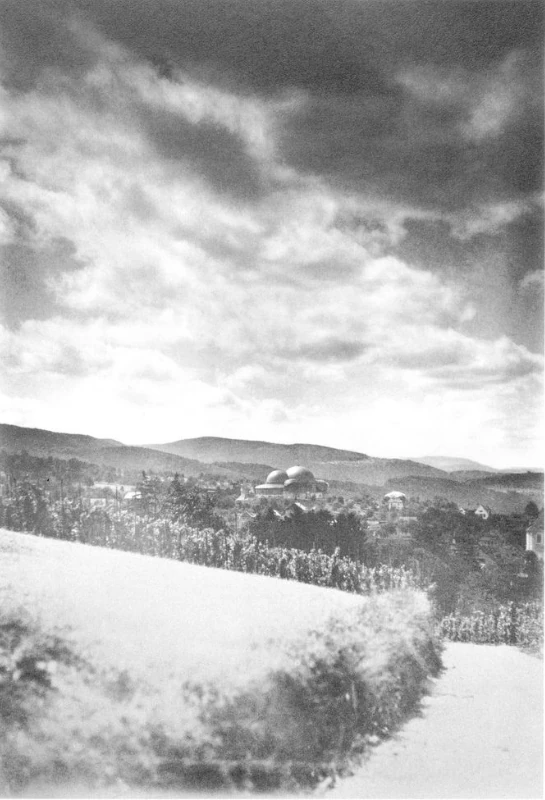
Von einer anderen Seite aus repräsentiert sich der Bau in dieser Weise.
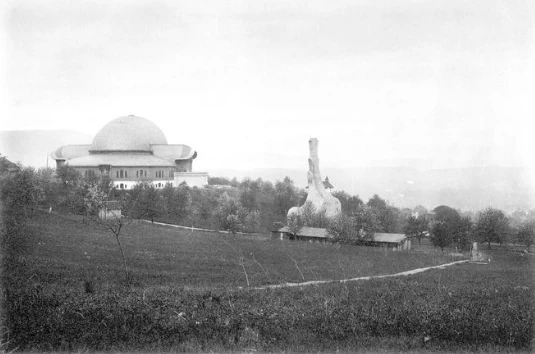
Ein weiteres Bild aus dem Umblicke:
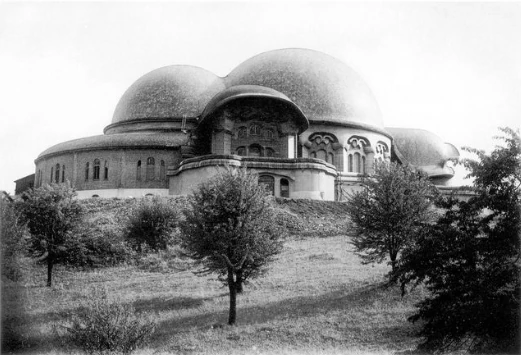
[ 10 ] Es wird vor allen Dingen notwendig sein, auf die einzelnen Formen zu sehen. 1908 hat sich mir zuerst der Gedanke ergeben, den Bau als einen solchen Doppelkuppelbau aufzuführen. Es war ja an dem Baugedanken manches dadurch geändert worden, dass ursprünglich gedacht war, den Bau in einer Stadt, in München, aufzuführen, wo er rings umgeben gewesen wäre von Häusern, wo also die Außenarchitektur weniger in Betracht gekommen wäre. Als der Bau umzukonstruieren war für den hiesigen Hügel, da handelte es sich natürlich darum, ihn auch nach außen hin architektonisch so zu gestalten, dass er nach den verschiedenen Seiten der Umgebung hin richtig wirkt. Hier wollen wir zunächst einmal ins Auge fassen, dass der ganze Bau auf einer Art Rampe errichtet ist, sodass er also nicht unmittelbar auf dem Boden aufsteht.
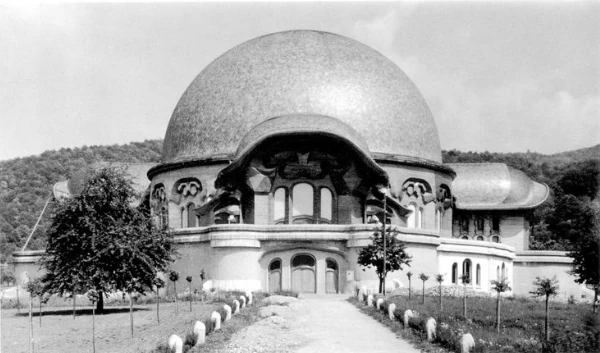
[ 11 ] Wir kommen jetzt dem Bau schon näher und haben hier ein Bild dem Haupteingange gegenüber. Nun bitte ich Sie zu berücksichtigen, dass man hineingeht zunächst in den Unterbau, dass dann, wie wir sehen werden, angehörig diesem Unterbau die Treppe ist, durch die man in den Zuhörerraum hinaufsteigt. Dann kommt man erst durch das Haupttor in den eigentlichen Innenraum. Der Bau ist etwas über dem Niveau der unmittelbaren Bodenfläche erhaben. Es wird jedem, der sich dem Bau nähert, auffallen, namentlich wenn er sich dem Haupttor gegenüber befindet, dass hier der Versuch gemacht worden ist, von den bloß mathematisch-geometrisch-mechanischen Bauformen abzugehen und organische zu finden. Selbstverständlich können diejenigen Menschen, die ganz erfüllt sind mit den alten Anschauungen, die glauben, dass nur das Geometrisch-Dynamische in der Baukunst, in der Architektur eine Berechtigung habe, viel gegen diese Überführung der architektonischen Formen ins Organische einwenden. Diese Einwände kennt man alle. Allein es hat sich hier eben wirklich einmal darum gehandelt, das Wagnis zu unternehmen, die Bauformen ins Organische überzuführen.
[ 12 ] Dann aber war die Notwendigkeit gegeben, den ganzen Baugedanken so zu denken, wie man das Organische denkt. Verstehen, was ich damit eigentlich meine, wird nur der, der wirklich einmal versucht, was heute die wenigsten Menschen noch eigentlich wollen: in der Empfindung abzugehen von allem Symbolisierenden, Abstrakten, von allem bloß Mechanisch-Mathematischen, und der sich einlässt auf ein wirklich organisch-künstlerisches, empfindendes Denken. Nicht etwa, um die Form eines organischen Wesens symbolisch hier in Bauformen auszudrücken, handelt es sich, sondern darum, einzusehen, dass, um ein organisches Wesen zu begreifen, notwendig ist eine ganz bestimmte Art von intuitiven Gedankenformen. Man muss sich eingewöhnen in solche intuitive Gedankenformen. Und dann muss man in der Lage sein, ganz ursprünglich und elementar aus einem solchen intuitiven Denken heraus auch diese Bauformen zu finden.
[ 13 ] Ich möchte Sie aufmerksam machen auf etwas, wovon die meisten Menschen in der Gegenwart überhaupt noch gar keine Ahnung haben. Man kann nicht sagen: In der Natur sind organische Formen; wir bilden Bauformen, die nachgestaltet sind irgendwie den organischen Formen der Natur, die gewissermaßen symbolisch zum Ausdruck bringen die organische Form der Natur. So ist hier nichts entstanden. Für diese Bauformen hier gibt es kein Vorbild, das in der Natur unmittelbar vorhanden wäre. Und wer solche Vorbilder in der Natur sucht, der zeigt eben, dass er das Grundlegende desjenigen, um was es sich hier handelt, gar nicht verstanden hat.
[ 14 ] Das andere ist, dass man in der Lage ist, den Organismus wirklich zu verstehen. Dann, wenn man einen Organismus in der Natur versteht, dann hat man ein Denken, welches ganz unabhängig von der Natur auch organische Bauformen finden kann. Aber diese organischen Bauformen müssen ganz selbstständig und unabhängig gefunden werden, müssen aus ihrer eigenen Formwesenheit heraus geschaffen werden. Das Ganze trägt dann, wenn es wirklich aus einem organischen Baugedanken heraus gebildet ist, auch den Charakter des Organischen. Welches ist dieser Charakter des Organischen? Ja, meine lieben Freunde, nehmen Sie einen komplizierten Organismus, und nehmen Sie dann an diesem komplizierten Organismus nur ein Ohrläppchen. Wenn Sie richtig intuitiv denken und empfinden können, werden Sie sich sagen: Dieses Ohrläppchen an seiner Stelle könnte nie anders sein, als es ist; und es muss an dieser Stelle so sein, wie es ist; es hat die richtige Breite, es hat die richtige Höhe, es hat die richtige Rundung und so weiter. So muss hier an diesem organisch gedachten Bau jede einzelne Form sein. Alles Einzelne muss, indem es sich als ein Glied des Ganzen kundgibt, seine eigene Notwendigkeit in der Form offenbaren. Es muss sich das kleinste Anhängsel, das da oder dort auftritt, in seiner inneren Notwendigkeit so darstellen wie das Ohrläppchen oder wie ein Arm oder wie der Kopf am menschlichen Organismus.
[ 15 ] Es ist hier nichts nachgebildet der Natur. Und wer durch diese Formen an das eine oder das andere erinnert wird, der zeigt eben, dass er den Bau nicht künstlerisch beurteilt, sondern unkünstlerisch. Denn wenn ich durch irgendetwas am Bau erinnert werde - und an was alles sind schon die Menschen erinnert worden durch diese Bauformen, an menschliche Augenbrauen oder dergleichen, oder an Augen -, so zeige ich nur: Ich beurteile das Einzelne für sich, während jede Einzelheit an diesem Bau nur eine Bedeutung hat im Zusammenhang mit dem Ganzen und aus dem Ganzen heraus begriffen werden muss.
Das nächste Bild zeigt dasselbe, etwas näher:

[ 16 ] Sie haben unten den Eingang. Man kommt zunächst in die Garderobenräume, dann links und rechts, wo der Unterbau eine Rundung ist, ist das Treppenhaus. Man kommt dann auf die Rampe hinauf und geht durch das Hauptportal in das Innere hinein. Das Motiv, das einem am Hauptportal entgegentritt oben, das ist eben ein solches organisches Motiv. Und wenn Sie die verschiedenen Motive, die an den verschiedenen Seiten des Baues zu finden sind, nehmen, so werden Sie überall finden: Sie sind nach dem organischen Metamorphosenprinzip gebildet, sodass sich das eine aus dem anderen immer als Entwicklung ergibt. Schen Sie sich zum Beispiel dieses Motiv an, welches hier oben am Hauptportal ist. Wenn Sie es in seinen Formen empfinden, so werden Sie wieder empfinden können dieselbe Form an den Fenstermotiven des Seitentraktes, den Sie hier besonders deutlich sehen nach dem Süden hin (Abb. 14). Scheinbar ganz andere Motive sind diese Fenstermotive. Aber Sie werden an ihnen sehen können, dass sie sich so ergeben aus dem Hauptportalmotiv, wie etwa nach dem Prinzip der Goethe’schen Metamorphosenlehre die einzelnen Organe der Blüte sich ergeben aus dem Blatt. Es ist eine andere Metamorphose desselben Motivs. Man kann nur einen organischen Baugedanken entfalten, wenn man das Prinzip der Metamorphose wirklich innerlich intuitiv erfasst.
[ 17 ] Sie sehen gerade bei dem, was sich links und rechts an den Haupteingang anschließt (Abb. 10, 15), den Versuch gemacht, so, wie in der organischen Natur selber gestaltet ist, zu verfahren, aber ohne dass irgendetwas Organisches nachgeahmt ist, nämlich so, dass das eine Motiv aus dem anderen hervorgeht. Sie sehen jeder Linie, jeder Fläche an, dass sie aus der anderen nach demselben Prinzip hervorgeht, wie, sagen wir, zum Beispiel beim Menschen die Wangenfläche aus der Schläfenfläche hervorgeht. Dieses Hervorgehen der Wangenfläche aus der Schläfenfläche, man kann es wirklich innerlich studieren. Man muss nur loskommen von der rein intellektualistischen Weltanschauung. Man muss die Welt in Formen anschauen können, ohne zum Symbolismus zu kommen. Dann wird man einsehen, wie eine Fläche, eine Form aus der anderen so entsteht, dass sie wirklich herausgewachsen sein könnte, und dass sie außerdem an dem Orte, wo sie ist, durchaus räumlich gerechtfertigt ist.
[ 18 ] Sehen Sie, an diesem ganzen Bau ist kein einziges bloßes Symbolum. Als unsere Bewegung noch durch Menschen, die sich an ihr beteiligten, viel Sektiererisches in sich hatte, viel verkehrt Mystisches, das ja von mir immer bekämpft werden musste — aber es waren sehr viel mystisch-sektiererische Anlagen in den verschiedenen Menschen, die von verschiedenen Seiten zu unserer Bewegung herankamen -, da entsetzten sich oftmals gerade künstlerische Naturen, die in unsere Räume hereinkamen, über das Symbolisierende. Irgendwo ein Rosenkreuz, ein Kreuz mit sieben Rosen, dilettantisch gemacht, galt den Leuten mehr als ein wirklich künstlerisches Motiv. Das dürfte nun an diesem Bau endlich endgültig überwunden sein, und das unmittelbar Schöpferische ohne den Durchgang durch das Symbolisieren, das unmittelbar Schöpferische einer Weltanschauung im Formalen, das sollte an diesem Bau nun zum Ausdrucke kommen.
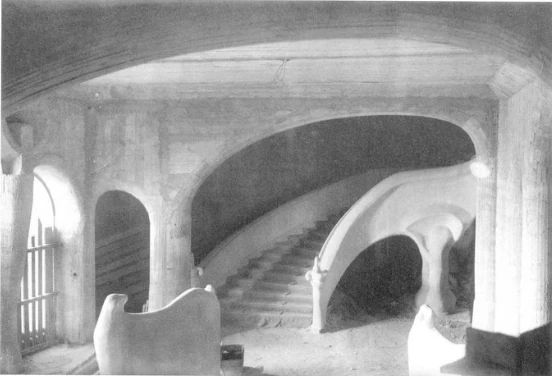
[ 19 ] Ich bitte Sie, immer bei diesen Formen darauf Rücksicht zu nehmen - selbstverständlich ist alles ein Anfang -, dass der Versuch gemacht ist, die Flächen so zu gestalten, dass sie sich nach den entsprechenden Kräftelagen richten. Wenn Sie zum Beispiel durch den Haupteingang des Unterbaues hineingehen, so werden Sie dort Bogen schen. Studieren Sie einmal die Formung dieser Bogen, und Sie werden sehen: Diese Formung ist so, dass die Linie des Bogens genau folgt der Kräfteverteilung im Bau. Da, wo es zum Tore geht, wo also eine geringe Belastung vorliegt, da greift der Bogen aus; da, wo der Bogen sich hinwölbt gegen den Bau, da biegt er sich ein, er stemmt sich. Sodass also die Formung des Bogens durchaus den Lasten, den Kräfteverteilungen folgt. So die Formen empfinden heißt eben einen organischen Baugedanken fassen.

[ 20 ] Da kommen wir zu der nördlichen Seitenansicht. Sie sehen hier in dem zwischen dem Hauptportal und dem Nordtrakt liegenden Teile das Motiv des Hauptportals in Metamorphose über dem dreiteiligen Fenster. Sie können da studieren, wie die einzelnen Formen so metamorphosiert sind, dass zum Beispiel Rücksicht darauf genommen ist, wie das Motiv der Seitenwand folgt. Während man in den Haupteingang hineingeht, kommt einem das Motiv entgegen, während man hier an dem Motiv vorübergeht. Dieses Entgegenkommen und Vorübergehenlassen, das sind solche Dinge, die bei einem organischen Baugedanken zum Ausdrucke kommen müssen. Es ist dasselbe Motiv in anderer Metamorphose. So ist auch dasjenige gestaltet, was nach oben hin abschließt, was gewissermaßen überdacht das Motiv. Auch das ist anders gestaltet, aber wiederum nur in Metamorphose anders gestaltet als das Hauptportal-Motiv.

[ 21 ] Da haben Sie die Seitenansicht des Seitentraktes. Gerade an diesem Fenstermotiv können Sie studieren, wie man organische Formen ausgestaltet. Was hier die Fenster nach oben abschließt als Motiv, das ist genau dasselbe wie das Motiv, das Sie vorhin gesehen haben über den Fenstern, und das Motiv, das Sie über dem Hauptportal haben. Aber beim organischen Wachstum ist es so, dass die Metamorphosen dadurch entstehen, dass dasjenige, was an dem einen Gebilde kräftiger, breiter ausgebildet ist, sich beim anderen verkürzt, zusammenzieht, anderes, was bei einer früheren Bildung primitiver ausgebildet ist, sich mehr verzweigt. Darauf beruht ja gerade die Metamorphose. Und diese Metamorphose sehen Sie hier durchgebildet.
[ 22 ] Außerdem mache ich Sie aufmerksam darauf, dass wenigstens das Bestreben vorhanden war, bei diesem ganzen Bau Bauwahrhaftigkeit, architektonische Wahrhaftigkeit zu entwickeln. Das ist etwas, was man in der heutigen Welt eigentlich nur noch wenig versteht. Das bloß Renaissancehafte sehen Sie hier überwunden. Sie sehen diese Fenster nicht bloß dekorativ ausgestaltet, sondern Sie sehen sie unten aufstehen. Es ist an diesem ganzen Bau nichts zu finden, was nicht zu gleicher Zeit verrät, was es ist. Es lügt nichts an diesem Bau, während gerade bei jetzigen Baugedanken so ungeheuer viel Erlogenes und Verlogenes ist. Wir haben ja in unserer Kultur gerade in den Formen so viel Erlogenes, dass es schließlich nicht wunderbar ist, dass wir auch in dem, was die Menschen sprechen, so viel Erlogenes haben. Hier ist anderes versucht worden: Wo etwas auftritt, soll es tatsächlich unmittelbar der Ausdruck desjenigen sein, was es ist. Das ist beim Symbolismus niemals der Fall, denn dieser hat immer etwas Willkürliches in sich. Das bitte ich Sie zu berücksichtigen.

[ 23 ] Hier haben Sie dann den Seitentrakt in seiner Fassade. Sie haben dasjenige, was über dem Hauptportal ist, in einer anderen Metamorphose. Natürlich ist bei alldem, was Sie hier sehen, zu berücksichtigen, dass es ein Anfang ist. Ich sage es jedem, der es hören will, immer wiederum: Ein zweites Mal würde der Bau, gemacht von mir selber, ganz anders werden. Es ist eben ein Versuch. Aber im Einzelnen kann man ihm doch wohl ansehen, was eigentlich gewollt ist, wie der organische Baugedanke durchgeführt ist, wie zum Beispiel die bloß mathematisch-geometrisch-dynamische Säulenform überall ins Organische übergeführt ist, sodass nirgends bloß anschaulich ist das Prinzip des Tragens oder des Lastens, sondern überall drinnen ist das Prinzip des Wachsens, des Auseinanderhervorgehens, was, wie wir dann morgen sehen werden, insbesondere bei der Innenarchitektur in ausgeprägtestem Maße versucht worden ist durchzuführen.
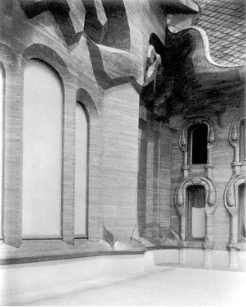
Da ist der Anschluss von der Seite, von der Ecke her.
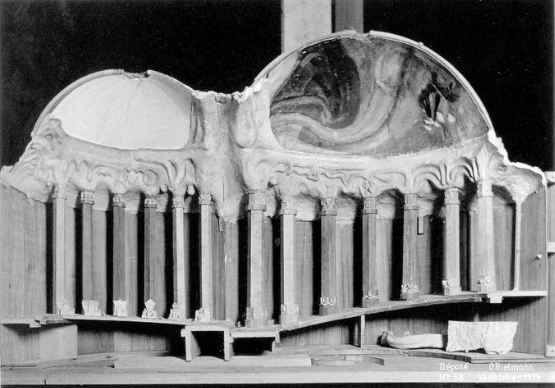
[ 24 ] Hier haben Sie nun das Bild von meinem ursprünglichen Modell. Ich wollte Ihnen zuerst eine Vorstellung geben von der Idee, die sich ergibt beim Annähern an den Bau. Ich wollte Ihnen zeigen, wie der Bau wirken soll, wenn man um ihn herumgeht. Nun führe ich Sie vor das Innere, so wie es sich darstellt nach meinem ursprünglichen, in Holz und Wachs ausgeführten Modell. Dieses Modell lag ja dem ganzen Bau zugrunde. Sie haben es hier in der Mitte durchschnitten. Dadurch sehen Sie unter der großen Kuppel die sieben aufeinanderfolgenden Säulen, welche in der Rundung den Zuschauerraum abschließen. Dann haben Sie hier die Stelle des Vorhanges, die Mitte; und hier haben Sie unter der kleinen Kuppel die sechs von den zwölf Säulen, welche den kleinen Kuppelraum umkreisen. Dieser Schnitt, der hier geführt wird, geht vom Westen nach Osten. Im Osten wird dann stehen die Hauptgruppe: der Menschheitsrepräsentant, vom luziferisch-ahrimanischen Elemente umrahmt. Über das Prinzip, nach dem diese Säulen mit ihren Kapitellen und Architraven gebildet sind, werde ich morgen sprechen.
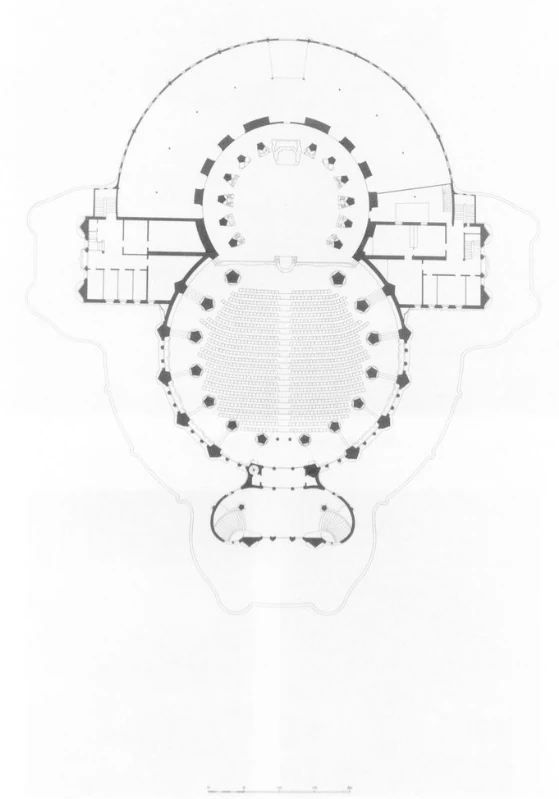
[ 25 ] Hier haben Sie den Grundriss des Baues, hier den Haupteingang, ringsherum die Rampe, hier den Zuschauerraum und hier den kleinen Kuppelraum, den Ort, wo aufgeführt werden sollen Mysterien, wo die Eurythmie-Aufführungen und so weiter sein sollen, beides getrennt durch den Vorhang, und in der Trennungslinie von beidem wird ja auch das Rednerpult stehen. In der Trennungslinie liegen dann die zwei Seitentrakte, die dazu bestimmt sind, dass diejenigen, die etwas zu tun haben mit den Aufführungen, dort ihre Garderoben haben werden und so weiter.
[ 26 ] An diesem Grundriss können Sie sehen, dass dem ganzen Bau eine gewisse Notwendigkeit zugrunde liegt. Wenn ich über diesen Grundriss spreche, so habe ich immer eine gewisse Sorge, dass man den eigentlichen Baugedanken missverstehen kann. Ich habe hier einmal einen Vortrag gehalten über die Grundrissform, und diese Grundrissform parallelisiert mit der menschlichen organischen Gestalt. Das verstehen dann wiederum gleich manche Zuhörer so, als ob der Bau symbolisch nachgebildet sei der menschlichen Form. Das ist aber durchaus nicht der Fall, sondern wer in der Lage ist, die menschliche Form wirklich zu verstehen, wie sie auf der einen Seite das Denkerische ist, auf der anderen Seite das Willensgemäße, das durch das Gemüthafte zusammengebunden ist, wer das Ganze versteht, Hauptesbildung, Gliedmaßenbildung mit der Rumpfbildung, mit der Herzensbildung in der Mitte, der ist auch in der Lage, andere organische Formen auszubilden. Und eine solche andere organische Form ist dieses. Es ist eben organisch gestaltet. Daher, wenn dieses hier vorliegt und die organische Form des Menschen vorliegt, wird man eine Beziehung zum Menschen finden können. Aber es handelt sich durchaus nicht darum, dass das eine dem anderen nachgebildet ist, sondern es ist hier wirklich die organische Bauform aus dem Organisch-Schöpferischen des Natur- und Weltenwirkens selber heraus gestaltet. Dasselbe können Sie ansehen dem Querschnitte, den ich Ihnen jetzt zeigen werde; hier ist der Querschnitt von Osten nach Westen geführt.
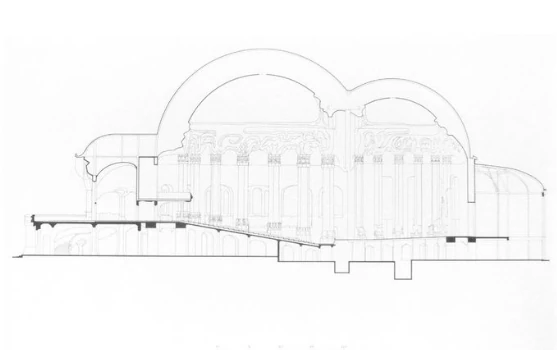
[ 27 ] Die kleine Kuppel, die sich verbindet mit der großen Kuppel, ist in der Mitte durchschnitten, von Ost nach West. Der ganze Bau hat nur eine Symmetrieachse, und symmetrisch ist alles in Bezug auf diese Symmetrieachse angeordnet. Das bedingt, dass eben gerade der Baugedanke ein organischer sein muss, denn das Organische ist so gestaltet, dass es sich in einer gewissen Achse entwickelt, wenn es ein höheres Organisches ist. Nur gewisse niedere organische Formen sind zentral angeordnet. Und man kann annehmen, dass einmal aus dem, was hier angestrebt worden ist, gewisse vollkommenere Bauformen, als die Zentralbauten sind, heraus entstehen werden, weil eben das Prinzip des organischen Wachsens in einer Achse wirklich hier einmal angestrebt worden ist.

[ 28 ] Hier sehen Sie den Raum, in den man zunächst hineinkommt, wenn man durch das Tor des Unterbaues hineingeht. Dann hat man hier die Treppe, über die man hinaufgeht, um oben auf die Rampe zu kommen, über die man dann durch das Hauptportal in den eigentlichen Raum, über den wir morgen sprechen werden, hineinkommen kann. Sie sehen, wenn Sie.der Treppe zu gehen, hier unten ein merkwürdiges Gebilde (Abb: 24). Das, was dieses Gebilde ist, wird vielleicht nur derjenige vollständig erfassen können, der wirklich absieht von allem bloß Intellektuellen und auf das Künstlerische zu sehen in der Lage ist. Als diese Form hier ausgebildet werden sollte, da sagte ich mir: Wer über diese Treppe hinaufgeht, der muss an irgendetwas einen Anhaltspunkt haben für die Stimmung, die man im Hinaufgehen haben soll. Und nun sehen Sie sich diese drei Formen an, die aufeinander senkrecht stehen in den drei Raumrichtungen. Aber es genügt nicht, dass Sie bloß dieses aufeinander senkrecht Stehen ins Auge fassen, sondern Sie müssen das Überhängende dieser Formen ansehen, das sich Ausbuchtende, das Lastende, im Überhängenden Lastende.
[ 29 ] Wenn Sie die ganze Form durchempfinden, dann wird sie Ihnen ein Ausdruck der Stimmung sein, die man für die wünschenswerte halten kann, wenn man über diese Treppe hinaufgeht. Wer über diese Treppe hinaufgeht, soll ein Vorgefühl davon haben: In diesem Bau des Goetheanum findet er etwas, was ihm Festigkeit, Sicherheit, Kraft im Leben gibt, was ihm etwas gibt, ohne dass man gewissermaßen seelisch umfällt. Davon soll man ein Vorgefühl hier haben. Rein aus diesem Gefühl heraus ist diese Form entstanden. Ich möchte sagen, nur nachträglich sollte man fühlen, wie diese Form so sein muss, dass sie, wenn auch nicht in sklavenhafter Nachbildung, doch etwas ähnlich ist den drei halbzirkelförmigen Kanälen, die die kleinen Gehörknöchelchen im menschlichen Ohre bilden. Wird dieses Organ im menschlichen Ohr verletzt, so fällt der Mensch um. Er verliert das Gleichgewicht. Es ist ein Gleichgewichtsorgan im menschlichen Organismus, ein ganz kleines, winziges Gleichgewichtsorgan.
[ 30 ] Man kann nun das Gefühl haben, dass hier so etwas sein muss, um im Gleichgewicht in diesen Raum einzutreten. Das ist nichts Ausspintisiertes, das ist etwas durchaus Empfundenes. Derjenige, der es als ausspintisiert versteht, der hat es sich selbst zuzuschreiben, denn er fängt an nachzudenken, nachzugrübeln, zu spekulieren. Es handelt sich aber nicht darum, dass man nachgrübelt, spekuliert, sondern dass man das Lastende im Überhängenden empfindet, dass man die Form empfindet, und im Empfinden eben die Stimmung fühlt, die einen überkommen kann, wenn man über diese Treppe hinaufgeht.
[ 31 ] Hier ist gerade eine derjenigen Bogenrichtungen, die nur verstanden werden kann innerhalb eines organischen Baugedankens. Stellen Sie sich einmal hierher im Bau und sehen Sie nach dieser Richtung hin und empfinden Sie den Bau, das heißt, empfinden Sie, wie man hier hereinkommt bezichungsweise herausgeht, empfinden Sie, wie man hier die Treppe hinaufgeht, dem Lastenden des ganzen Baues entgegengeht, dann werden Sie von diesem Schwung empfinden, dass er so sein muss. Sie werden aber auch empfinden, was gemeint ist in diesem Gebilde hier (Abb. 25). In solch einem Gebilde ist einmal der Versuch gemacht, das bloß Säulenmäßige, das Pfeilermäßige ins Organische überzuführen. Es ist dabei nichts anderes zugrunde liegend als das Formgefühl, das kommt, wenn man intuitiv das Tragende durchfühlt; dann muss diese Form herauskommen. Wer erinnert wird an einen Elefanten- oder an einen Pferdefuß, der mag daran erinnert werden, aber er zeigt, dass er nicht vom Künstlerischen ausgeht, sondern vom bloß Imitativen. Hier zu empfinden, wie getragen werden soll und wie dasjenige, was trägt, sich in diese Formen auswächst, nach dieser Richtung hin in diese Formen übergeht, in diese Bogenlinie nach der anderen Richtung hin sich aufstemmt, darum handelt es sich; nicht darum, etwas nachzuahmen, sondern die darinnen tragenden und lastenden Kräfte zu empfinden und ihnen entgegenzustellen die Formen, die tragen und Iasten können: Bei-dem gewöhnlichen Baugedanken empfindet man eigentlich nur das geometrisch-mechanisch-dynamische Tragende und Lastende. Hier dagegen soll in jeder Fläche, in jeder Linie zum Ausdruck kommen, wie gewissermaßen im Baulichen der Anfang des Fühlens des Lebendigseins enthalten ist.
[ 32 ] Wenn Sie diese Dinge, die ich heute erwähnt habe, wirklich entkleiden alles bloß Spekulativen, dann werden Sie die Sache in der richtigen Weise verstehen. Ich werde dann, von hier ausgehend, morgen fortfahren, Ihnen die Innenarchitektur darzulegen. Ich glaube, dass, wenn man zunächst einmal dasjenige, was dem Baugedanken zugrunde liegt, der Welt mitteilt und dann zeigt, wie hier etwas wirklich Neues hervorgeht aus anthroposophischer Weltanschauung in künstlerischen Formen, man der Welt ein Gefühl wird beibringen können, wie von hier aus weltanschaulich und - wie wir dann sehen werden morgen und übermorgen - auch sozial gewirkt werden kann. Heute wollte ich zunächst einmal diese Einleitung geben, morgen wollen wir von außen nach innen in unserem Bau fortschreiten.
First Lecture
[ 1 ] In a kind of episodic insertion into these lectures, which are now being held, I would like to present to you today something about our building, in such a way that our friends can have a kind of basis for their own work in what is presented here about this building. In the near future, our cause will really have to be advocated more strongly in many directions, and the Dornach building, the Goetheanum, will have to be placed at the center of what we as a movement want to assert for anthroposophically oriented spiritual science. It would be of extraordinary importance if what is here as the “Goetheanum” were also to become known to the outside world, including to those who do not now have the opportunity to see the building. The way in which this building presents itself to contemporary spiritual culture can, if our contemporaries become aware of it in the right way, work in the direction indicated in these reflections as a necessary contemporary direction. Therefore, today, since, as I said, I would like to provide a basis for what others can then carry out into the world, I will have to repeat some of what I have already presented in one context or another, so that a kind of whole may arise from what these episodic reflections will contain.
[ 2 ] What needs to be said first and foremost about the Dornach building is that it has outgrown the anthroposophically oriented worldview. It was able to grow out of it for the reason that this anthroposophically oriented worldview, if properly understood, has the inner strength to create forms, art and designs from within. Once again I would like to say what I have already said in a different context: if any of today's schools of thought, as they present themselves to the world with different programs, had needed their own dwelling at a certain point in time, they would have turned to this or that architect, to this or that artist, and would have built a kind of home, stylized in this or that way, in which that which wants to assert itself could then live. There would then be an external relationship between what is being done and a Renaissance building or an antique building or a Gothic building or the like.
[ 3 ] There should be no such external relationship between what I, as a world-view, wish to reveal here and that which encompasses its activities. It should be an inner relationship. Every single aspect of the dwelling of our activity, every single aspect of the forms and the designs should be created out of the impulses of this world view itself. If you consider this, you will see that it is connected with the whole position that anthroposophically oriented spiritual science wants to take in relation to the general development of humanity. Modern human life has become abstract and intellectual. This has come about because, for centuries, modern humanity has received almost only an education in thought. If someone wanted to create forms, they turned to what already existed in this or that old architectural style, just as one otherwise, when one wanted to create something artistic or the like, did not turn to the world view, but to something that was placed alongside the world view. Where did that actually come from?
[ 4 ] You see, in everything that asserts itself in human culture, two currents must flow together. These two currents go far back in the historical development of mankind. The one, which has received its most intellectual expression in the last few centuries, goes back to what one can call the view of the Old Testament. We must never lose sight of the fact that an essential part of these views of the Old Testament was: You shall not make for yourself an image of your God. The pictorial representation of that which is spiritual was something that this one current of human development lacked. And so it has remained to this day in what has become of this one current of human development.
[ 5 ] There is much thinking, philosophizing, and scientific inquiry, and popular worldviews are developed. But these sciences, these philosophies, these religious currents do not succeed in creating artistic forms out of themselves. But actually, only the unartistic element of the world view striving has an inner relationship in modern times. Modern times do not have a direct human relationship to giving form, to shaping the pictorial.
[ 6 ] But there are two ways of entering the spiritual world: One can penetrate the spiritual world abstractly, just as the monotheistic religions penetrate abstractly. In this case, one develops primarily the intellectual element, the abstract. In this way, one can go far in that which the modern age has brought forth. But one can also educate the element that lies in the pictorial, the element of contemplation, of life in the creative process. In this element, newer humanity lived inwardly little. It renewed old styles, old pictorial forms, but did not achieve an inner relationship to them. Indeed, it has come to such a pass that on the one hand those who want to create artistically are almost afraid of any kind of world view, because a certain fear is indeed justified in the face of the latest world view, which is non-pictorial, abstract. But on the other hand, this has had a very particular disadvantage for the development of modern humanity. And this disadvantage is evident in the signs of decline in recent times. Some time ago I already pointed out here how present-day people's striving contains something of the Old Testament, of the striving of the Jahwe, how one would like to make each individual people, so to speak, what the ancient Hebrew people wanted to make of themselves, how Christianity as such has not yet moved into the hearts of newer humanity in its fullness. And so, in social life, too, a certain abstract thinking has developed, a certain abstract feeling for the connection between people. But the human being as such and human communities cannot be understood from the standpoint of mere intellectualism. What the human being is, and also what the human being is meant to be in social life, can only be grasped if one rises to figurative contemplation.
[ 7 ] And anyone who is familiar with the laws in this area knows that even fairy tales, legends and mythologies contain more wisdom about the actual nature of man than more recent science, which does not have the means to educate man about man. People are afraid of the light of the spiritual, which can only shine into our human culture in images. But human cultural life will not improve unless a worldview takes hold of people's hearts that is capable not only of shaping thoughts, but also of creating a way of life that permeates all of life. With this, however, we would like to make a start here with this building. It is only meant to be a beginning, but in its peculiarity it should show everything that a truly creative world view of the present and especially of the future must have. Everything that characterizes this world view, as represented here, is present in the picture when you stand before the representative of this world view, the Goetheanum here on the hill of Dornach.
[ 8 ] If we want to characterize in a few lines what is peculiar to this world view, we have to say: Above all, it is characterized by the realization that a new spiritual life must reveal itself to humanity in this time. That a new spiritual life should reveal itself must be sensed in the structure that is to represent the spread of this spiritual life. You have to feel it as you approach this building. Anyone approaching this building from the surrounding area must have the feeling: something will be revealed here in this building that will present itself as something new in the development of humanity. You have given the shape of this building from the outset: the penetration of something new into the development of humanity. Two not quite closed cylinders, covered by not quite closed hemispheres, express the duality of that which reveals itself and that which receives the revelation. And the predominating of the two domes will suggest to the one who approaches the building: something is enclosed here, that is being covered, but that wants to reveal itself.
[ 9 ] Do not take what I say in a symbolizing sense; take it in an artistic sense, and then you will develop the right understanding for it. I will talk about these things more, but today we want to get an overview of the different outward effects of the building forms and what our movement wants. So let us first imagine: If someone approaches the hill on which the Goetheanum is built from the northeast, for example, from any point in the surrounding area, they will be able to see: here stands a building (Fig. 1) that cannot be accompanied by any other forms. And that is a feeling that one should experience when looking directly at the representative of this world view.

The building is represented in this way from a different side.

Another picture from the panorama:

[ 10 ] Above all, it will be necessary to look at the individual forms. In 1908, I first had the idea of building the structure as a double-domed structure. After all, some of the architectural ideas had been changed because it was originally intended to build the structure in a city, in Munich, where it would have been surrounded by houses and where the exterior architecture would have been less of a consideration. When the building was redesigned for the local hill, the aim was, of course, to give it an outward architectural form that would make it look right in its surroundings from all sides. Here, we want to consider first of all that the whole building is constructed on a kind of ramp, so that it is not directly on the ground.

[ 11 ] We are now getting closer to the building and have a picture facing the main entrance. Now I ask you to consider that you first enter the substructure, and then, as we shall see, the staircase leading up to the auditorium is part of this substructure. Then you enter the actual interior through the main gate. The building is slightly raised above the level of the immediate ground surface. Anyone approaching the building will notice, especially when they are standing opposite the main gate, that an attempt has been made here to move away from purely mathematical, geometric and mechanical forms of construction and to find organic ones. Naturally, those people who are completely imbued with the old views, who believe that only the geometric-dynamic has a right to exist in building and architecture, can object to this transference of architectural forms into the organic. We are familiar with all these objections. But here, for once, it was really a matter of daring to transpose building forms into the organic.
[ 12 ] But then there was the necessity of conceiving the entire building idea in the same way that one conceives the organic. Only those who really try to do what very few people actually want to do today will understand what I mean by this: to depart in feeling from everything that is symbolic, abstract, or merely mechanical and mathematical, and to engage in truly organic-artistic, intuitive thinking. It is not about expressing the form of an organic being symbolically here in building forms, but about realizing that in order to understand an organic being, a very specific kind of intuitive thought forms is necessary. One has to familiarize oneself with such intuitive thought forms. And then one must be able to find these building forms in a very original and elementary way, from such intuitive thinking.
[ 13 ] I would like to draw your attention to something that most people today know nothing about. You cannot say: there are organic forms in nature; we create building forms that are somehow modeled on the organic forms of nature, which symbolically express the organic form of nature. Nothing has been created here in this way. There is no model for these structures here that would be directly present in nature. And anyone who seeks such models in nature simply shows that they have not understood the fundamentals of what this is all about.
[ 14 ] The other thing is to be able to really understand the organism. Then, when you understand an organism in nature, you have a thinking that can also find organic forms quite independently of nature. But these organic forms must be found quite independently and autonomously, must be created out of their own form presence. The whole thing then also bears the character of the organic, when it is really formed out of an organic building thought. What is this character of the organic? Yes, my dear friends, take a complex organism and then take just an earlobe from this complex organism. If you are able to think and feel intuitively, you will say to yourself: this earlobe in its place could never be other than it is; and it must be as it is in this place; it has the right width, it has the right height, it has the right curve and so on. Every single form must be like this in this organically conceived structure. Every single part, by manifesting itself as a link in the whole, must reveal its own necessity in the form. The smallest appendage, appearing here or there, must present itself in its inner necessity as the earlobe or as an arm or as the head in the human organism.
[ 15 ] Nothing here is modeled on nature. And anyone who is reminded of one thing or another by these forms merely shows that he judges the structure not artistically, but in an unartistic way. If I am reminded of something by the building – and people have been reminded of so many things by these shapes, of human eyebrows or the like, or of eyes – then I am only showing that I am judging the individual element in isolation, while every individual feature of this building only has a meaning in connection with the whole and must be understood from the point of view of the whole.
The next picture shows the same thing, a little closer:

[ 16 ] They have the entrance at the bottom. You first come to the cloakroom areas, then to the left and right, where the substructure is rounded, is the staircase. You then come up to the ramp and go through the main portal into the interior. The motif that confronts you at the main portal above is just such an organic motif. And if you take the various motifs found on the different sides of the building, you will find everywhere: they are formed according to the organic principle of metamorphosis, so that one always develops out of the other. Take a look, for example, at the motif that is here at the top of the main portal. If you feel it in its forms, you will be able to feel the same motif in the window motifs of the side wing, which you can see particularly clearly here facing south (Fig. 14). These window motifs appear to be quite different. But you will be able to see from them that they arise from the main portal motif in the same way that, according to the principle of Goethe's theory of metamorphosis, the individual organs of a flower arise from the leaf. It is a different metamorphosis of the same motif. One can only develop an organic building idea if one truly intuitively grasps the principle of metamorphosis.
[ 17 ] You can see that, in what is attached to the left and right of the main entrance (Figs. 10, 15), an attempt has been made to proceed as in organic nature itself, but without imitating anything organic, namely, so that one motif emerges from the other. You can see from every line and every surface that it emerges from the other according to the same principle as, for example, the cheek surface emerges from the temple surface in the human being. This emergence of the cheek surface from the temple surface can actually be studied inwardly. One must only free oneself from the purely intellectualistic world view. One must be able to look at the world in forms without resorting to symbolism. Then you will see how one surface or form arises out of another in such a way that it could really have grown out of it, and that it is also spatially justified in the place where it is.
[ 18 ] You see, there is not a single empty symbol in the whole structure. When our movement still had a great deal of sectarianism in it, due to the people who participated in it, a great deal of false mysticism, which I always had to fight against. But there were a great many mystical and sectarian tendencies in the various people who approached our movement from different sides. A rose cross, a cross with seven roses, done in a dilettante way, meant more to people than a truly artistic motif. This should now finally be overcome in this building, and the directly creative without the passage through the symbolic, the directly creative of a worldview in the formal, should now be expressed in this building.

[ 19 ] I would ask you to always bear in mind with these forms – it goes without saying that everything is a beginning – that an attempt has been made to shape the surfaces so that they are aligned with the corresponding forces. If you enter through the main entrance of the substructure, for example, you will see arches there. Study the shape of these arches and you will see that they are formed in such a way that the line of the arch exactly follows the distribution of forces in the building. Where it goes to the gate, where there is a low load, the arch extends; where the arch curves towards the building, it bends inwards, bracing itself. So the shape of the arch follows the loads, the distribution of forces. To perceive the forms in this way is to grasp an organic building idea.

[ 20 ] Here we come to the northern side view. Here, in the section between the main entrance and the north wing, you see the motif of the main entrance in metamorphosis above the three-part window. You can study how the individual forms have been metamorphosed in such a way that, for example, consideration has been given to how the motif follows the side wall. As you enter the main entrance, the motif comes towards you, whereas here you pass by it. This coming towards you and letting it pass are the kinds of things that must be expressed in an organic architectural concept. It is the same motif in a different metamorphosis. The design of the top part, which, as it were, covers the motif, is the same. This is also designed differently, but again only in a different metamorphosis than the main portal motif.

[ 21 ] Here you have the side view of the side wing. You can study how organic forms are designed, especially in this window motif. The motif that tops off the windows here is exactly the same as the motif that you saw earlier above the windows, and the motif that you have above the main portal. But in organic growth, metamorphoses arise from the fact that what is stronger and more broadly developed in one structure is shortened and contracted in the other, while what is more primitive in an earlier development is more ramified. That is precisely what the metamorphosis is based on. And you can see this metamorphosis fully developed here.
[ 22 ] Furthermore, I would like to draw your attention to the fact that at least the effort was made to develop architectural truthfulness in this entire construction. This is something that is actually poorly understood in today's world. You can see that the mere idea of a Renaissance has been overcome here. You see that these windows are not merely decorative, but you can also see that they are set below. There is nothing about this entire building that does not reveal what it is at the same time. Nothing about this building is a lie, while there is so much lying and deception in current architectural ideas. In our culture, we have so much that is false in the forms themselves that it is not surprising that we also have so much that is false in what people say. Here, something different has been attempted: where something appears, it should actually be the direct expression of what it is. This is never the case with symbolism, because there is always something arbitrary about it. I ask you to bear this in mind.

[ 23 ] Here you have the side wing in its façade. You have what is above the main entrance in a different metamorphosis. Of course, it must be taken into account that what you see here is just a beginning. I always say to anyone who will listen: if I were to build it myself, it would be completely different. It is just an experiment. But in the details, one can clearly see what was actually intended, how the organic building idea was implemented, for example, how the purely mathematical-geometric-dynamic column form is transformed into the organic everywhere, so that nowhere is it merely The principle of bearing or bearing weight is not merely visible, but the principle of growth and emergence is everywhere inside, which, as we will see tomorrow, has been particularly well attempted in interior design.

This is where the corner connects from the side.

[ 24 ] Here is a picture of my original model. I wanted to give you an idea of the idea that arises when approaching the building. I wanted to show you how the building should look when you walk around it. Now I will show you the interior as it appears after my original model, made in wood and wax. This model was the basis for the entire building. You have cut through it here in the middle. This shows the seven columns under the large dome, which end the curve of the auditorium. Then you have the place of the curtain, the center; and here you have the six of the twelve columns under the small dome, which circle the small dome room. This section, which is shown here, runs from west to east. In the east, then, will stand the main group: the Representative of Humanity, surrounded by the Luciferic-Ahrimanic element. I will speak tomorrow about the principle according to which these columns, with their capitals and architraves, are formed.

[ 25 ] Here you have the floor plan of the building, here the main entrance, around it the ramp, here the auditorium and here the small domed room, the where the mysteries were to be performed, where the eurythmy performances and so on were to take place, both separated by the curtain, and in the dividing line between the two, the lectern will also stand. In the dividing line, then, are the two side wings, which are intended for those who have something to do with the performances to have their dressing rooms there and so on.
[ 26 ] From this floor plan, you can see that the entire building is based on a certain necessity. When I talk about this floor plan, I am always concerned that the actual building idea may be misunderstood. I once gave a lecture here about the shape of the floor plan, and this floor plan is parallel to the human organic form. Some members of the audience then understand this as if the building were a symbolic reproduction of the human form. But that is absolutely not the case. Rather, anyone who is able to truly understand the human form, how it is, on the one hand, intellectual and, on the other, volitional, bound together by the emotional, anyone who understands the whole, the formation of the head, limbs and torso, with the formation of the heart at the center, is also able to form other organic shapes. And this is one such organic form. It is simply organically designed. Therefore, if this is present and the organic form of the human being is present, it will be possible to find a relationship to the human being. But it is not at all a matter of one being modeled on the other, but rather, here the organic structure is really designed out of the organic-creative of the natural and cosmic activity itself. You can see this from the cross-section that I am going to show you now; here the cross-section is from east to west.

[ 27 ] The small dome that connects to the large dome is cut in the middle, from east to west. The entire structure has only one axis of symmetry, and everything is arranged symmetrically in relation to this axis of symmetry. This requires that the architectural idea must be an organic one, because the organic is designed in such a way that it develops in a certain axis if it is a higher organic form. Only certain lower organic forms are arranged centrally. And one can assume that, from what has been striven for here, certain more perfect forms of construction than central buildings will arise, because the principle of organic growth in an axis has really been striven for here.

[ 28 ] Here you see the room that you enter first when you go through the gate of the substructure. Then you have the stairs here, which you go up to get to the top of the ramp, which then leads you through the main entrance into the actual room, which we will discuss tomorrow. You see, when you go up the stairs, there is a strange structure down here (Fig. 24). Perhaps only someone who is truly able to see beyond mere intellectual considerations and appreciate the artistic aspect will be able to grasp what this structure is. When this form was being designed, I said to myself: 'Those who go up these stairs must have some kind of reference point for the mood they should have while going up. And now look at these three forms, which are perpendicular to each other in the three spatial directions. But it is not enough just to look at them perpendicularly; you also have to look at the overhanging part of these forms, the bulging, the overhanging part of the load.
[ 29 ] If you feel your way through the whole form, it will give you an expression of the mood that one might consider desirable when going up these stairs. Those who ascend this staircase should have a presentiment of it: in this building of the Goetheanum they will find something that gives them stability, security and strength in life, something that gives them something without, so to speak, spiritually collapsing. One should have a presentiment of this here. This form has arisen purely out of this feeling. I would like to say that only in retrospect should one feel how this form must be so that it is, if not in slavish imitation, then somewhat similar to the three semicircular canals that form the small ossicles in the human ear. If this organ in the human ear is injured, the person falls over. He loses his balance. There is a balance organ in the human organism, a very small, tiny balance organ.
[ 30 ] One can now have the feeling that something like this must be here in order to enter this space in balance. This is not something that has been invented, it is something that has been thoroughly felt. Those who understand it as something invented have only themselves to blame, because they start to think, brood, speculate. But it is not a matter of brooding or speculating, but of feeling the burden of the overhanging, of feeling the form, and in the feeling, just feeling the mood that can overcome you when you go up these stairs.
[ 31 ] This is one of those curved directions that can only be understood within the context of an organic architectural concept. Imagine standing here in the building, looking in this direction and taking in the structure. That is to say, imagine entering or leaving the building, imagine going up the stairs and approaching the carrier of the entire structure. You will feel that this momentum must be so. But you will also feel what is meant by this structure here (Fig. 25). In such a structure, an attempt has been made to transform the mere columnar, the pillar-like, into the organic. There is nothing else underlying this but the sense of form that comes when one intuitively feels one's way through the load-bearing structure; then this form must emerge. Anyone who is reminded of an elephant's or a horse's foot may be reminded, but it shows that they are not starting from the artistic, but from the merely imitative. The point is to sense how something should be supported and how the thing that provides support grows into these forms, how it transitions into these forms in this direction, how it pushes up into this arched line in the opposite direction; it is not about imitating something, but about sensing the supporting and bearing forces within it and countering them with forms that can support and bear loads. In the case of ordinary architectural thought, one actually feels only the geometric-mechanical-dynamic carrying and bearing. Here, on the other hand, every surface, every line should express how, as it were, the beginning of the feeling of being alive is contained in the structure.
[ 32 ] If you really strip these things that I have mentioned today of all speculation, then you will understand the matter in the right way. I will then, starting from here, continue tomorrow to explain the inner architecture to you. I believe that if we first communicate to the world the ideas on which the building is based and then show how something truly new emerges from the anthroposophical worldview in artistic forms, we will be able to instill in the world a feeling for how we can work from here in a worldview-related and, as we will see tomorrow and the day after, social way. Today I wanted to give this introduction first, tomorrow we will move from the outside inwards in our construction.

